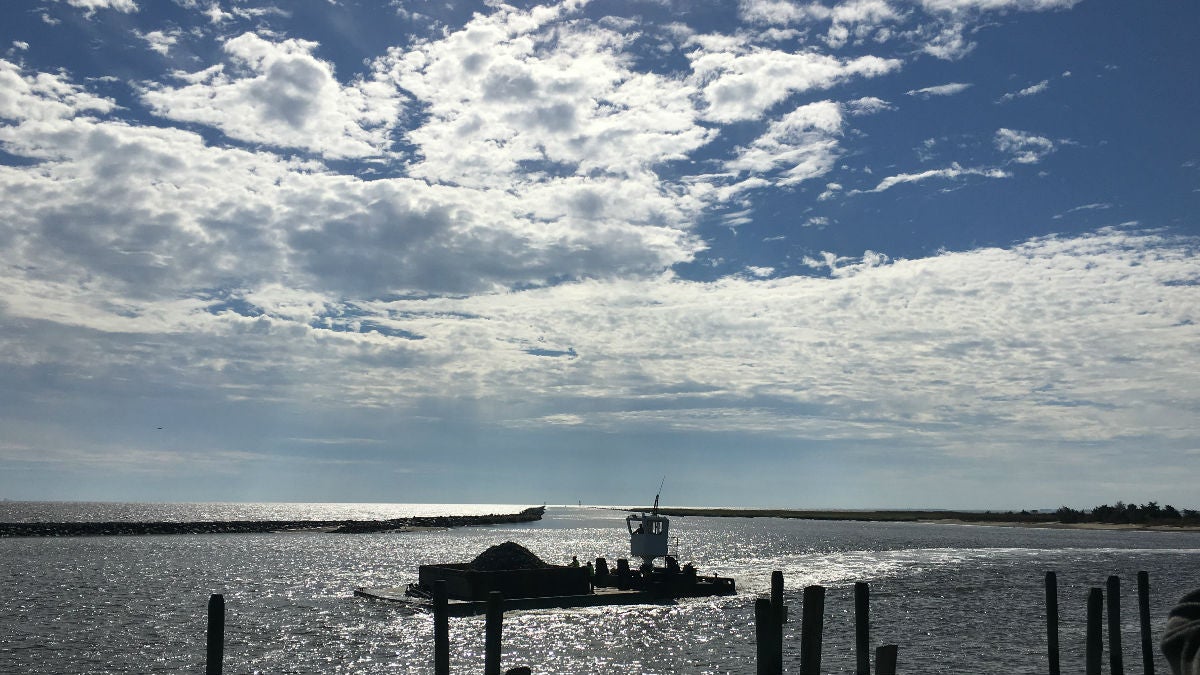Horseshoe crabs, red knots getting protection in Delaware
Listen
A tugboat pushes a barge full of rocks through Mispillion Harbor. (Mark Eichmann/WHYY)
When Hurricane Sandy ripped through the region in 2012, it caused significant damage at Delaware and New Jersey beaches, but it also caused damage further into the Delaware Bay. An effort to prevent future damage from storms like Sandy is underway at the Mispillion Harbor near Slaughter Beach.
A large backhoe off loads a delivery of rock from a nearby barge in Mispillion Harbor east of Milford. It’s delicate work for the operator of the big machine that also must fight winds and waves on the water to deliver the rock.
The rock is being used to better fortify the rock wall that protects Mispillion Harbor from the Delaware Bay. The harbor connects the Mispillion River to the Delaware Bay and is also a prime spot for horseshoe crabs.
“This is a really critical spot for horseshoe crabs, red knots, and there’s birders that come out here and other eco tourism,” said Jeremy Ashe, Delaware’s Habitat Restoration Project Manager along Delaware Bayshore.
That habitat is threatened by storms, especially Nor’easters that over-top the rock wall designed to protect the harbor, but hasn’t really been working that well, especially when facing big storms.
“Every time there’s a coastal storm, a nor’easter, the water actually goes over the rock wall,” Ashe said. “Every time the water goes over the rock wall it causes more and more erosion of back beach which is the specific habitat of the horseshoe crab and red knot, and we’ve seen increased habitat loss every year, in every coastal storm.”
So to improve the protection of the harbor and the beach, workers are doubling the height of the rock wall using giant rocks called R-7’s. Those rocks are placed on top of a filter fabric and smaller rocks that are designed to stop the water from coming through the wall. When the giant R-7’s are placed on top, they create a locking mechanism block water.
Once the rocks are in place, more than 4,000 dump trucks will deliver more than 46,000 cubic yards of sand. That extra sand will create a beach on the backside of the rock wall. a beach that could become home for thousands of horseshoe crabs
“That’s going to create over four acres of potential habitat for horseshoe crabs, which will spawn and then provide that habitat for red knots and a variety of other shore birds,” Ashe said.
The project is funded with Hurricane Sandy relief money, in part because of the damage that storm did here.
And as bad as hurricanes are, nor’easters often cause more damage.
“During a nor’easter, we’re going to have waves coming in from the northeast direction, and currently there is no rock to withstand that force,” Ashe said. “Every time there is a nor’easter, water is rushing through a breach, there’s actually a breach north of the rock wall, and we’re getting these large waves and large erosion on every nor’easter.”
A little further north, more Sandy money will help fund improvements to the Ted Harvey Wildlife Area south of Dover. Originally built to control mosquitoes, this impoundment is a prime spot for waterfowl, drawing hunters and birders alike. But a dike breach has rendered the impoundment unusable.
To rebuild the dike and restore water control, workers will add 40,000 cubic yards of dirt. Those repairs should be finished by next fall.
Both projects are part of the state’s Bay Shore Initiative, a program to improve the coastal area along the Delaware Bay. “These are the restoration components of the Bay Shore Initiative,” Ashe said. “Once we restore the habitat, we want to be able to allow the future generations and future people that come out and enjoy these habitats.”
The construction work on the Mispillion Harbor wall is moving forward full steam. Because the area is a sensitive habitat for horseshoe crabs and a stop-over for migrating red knots, the work must be completed no later than April 15, when those species are expected to return. DNREC expects to be done by February, well ahead of time.
The state applied for two competitive grants through the Department of the Interior’s Hurricane Sandy Coastal Resiliency program and was awarded a total of $6.5 million for both of these projects.
WHYY is your source for fact-based, in-depth journalism and information. As a nonprofit organization, we rely on financial support from readers like you. Please give today.





